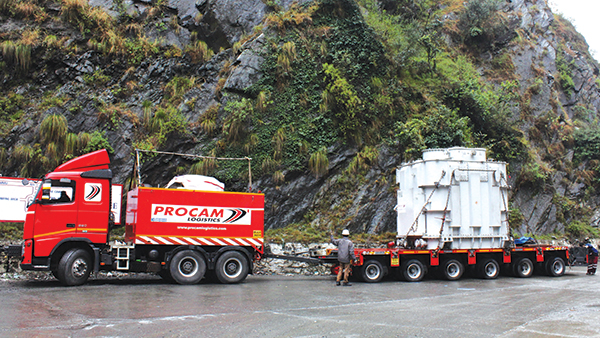Baglihar has two separate systems for energy transmission and both are efficiently working, reports Riyaz ul Khaliq
Even as weak geology of the mountains housing the dam and the power station threw up challenges, the transmission of the energy had its own bag of surprise because the line passed through various inaccessible areas. The two stages of the project have two different set-ups. While the Baglihar-I transmits energy to the grid at Kishenpur, Bagliahr-II has a system that it can evacuate energy to both sides, Wagoora in Kashmir and Kishenpur in Jammu.
The process for laying the transmission line started early 2001 when the Power Grid Corporation of India (PGCI) was hired to create a Detailed Project Report (DPR) on February 16, 2001. Getting clearance for PTCC and railway crossing clearance for the promoter SPDC was part of the contract. With DPR in hand, bids were invited.
Officials associated with the exercise said there were three offers for setting up the 400-KV, double circuit line between Baglihar and the Kishenpur: KEC, Larson & Toubro and TATA Power. Their bids were Rs 87.34 crore (KEC), Rs 88.50 crore (L&T) and Rs 97.50 crore (TATA power). For around 67 kms length of the line, it was KEC that had offered the cheapest per kilometer cost: Rs Rs 1.30 crore. The project was allotted to KEC International on turnkey basis on August 31, 2002, both for supply of the material and erection of line. Apart from towers and stringing the line, the contract included benching, earthwork of 80,000 cubic meters and creating protection of tower footings involving a total of 30,000 cum.
The line passing through forests and private land required a total of 98.75 hectors of land. Land acquisition is considered a longer process given the involvement of various individuals and the institutions.
Once the project implementation started, the track of the line changed course. With this changed the length, the costs, and the scope of work. With a new mid-implementation realignment, the line’s length jumped from 67 kms to 67.965 kms, the towers increased from initial 2015 to 215. Scope of work improved to 1.30,000 cums and the towers required a cumulative protection works of 65000 cums.
However, the requirement of the land remained the same: 98 hectors plus. Initially, the project paid Rs 58353780 as compensation to the forests – the line passes through three divisions in Batote, Udhampur and Jammu, but after the line was realigned for geological reasons, the revised requirement for funds was Rs 85543763. This is in addition to the privately owned that required more than Rs 13432115.
All these changes added to the cost of the project. Initially, it was supposed to cost slightly more than Rs 100 crore but it eventually was completed at Rs 168.03 crore. Of its first revised cost of Rs 120.68 crore, Rs 84.48 was loan component and the balance Rs 36.20 crore as equity. It retained the same mix of debt, equity after the costs changed, twice.
KEC sought two extensions in completing the job. Apart from delay in handing over of land right of way, an issue that promoters faced, it took a lot of time in negotiating inter-crossings. This implementation suffered for non availability of shut down for stringing of the line conductor at certain crossing points of existing 220 KV Kishpur-Pampore transmission line, 132 KV Kishenpur-Jajarkotli transmission line and 220 KV Kishenpur Salal transmission line.
Initially supposed to be ready by May 27, 2004, its first extension was up to November 30, 2005, second time extension was granted from Dec 1, 2005 to December 31, 2006 (with cost overruns) and finally from January 1, 2007 to March 31, 2007 (without any added cost).
The second stage, however, is short and less expensive. For evacuating the nergy from Baglihar-II, SPDC joined hands with the PGCI that has a 400-KV double circuit line passing through the area. The two created a LILO (line in and line out) not far away from the project itself.
“We have just 17 towers between the project and the point where our line connects with the 400-KV double circuit Kishenpur-Wagoor line that PGCI owns,” explains Baglihar’s Chief Engineer (electrical). “It has the capacity of evacuating 600 MWs power, either way.”
In fact, the project was bagged by the PGCI for implementation. It has outsourced its implementation to a third party Busbar.
SPDC and PGCI will have to ink an agreement to manage the interconnectivity of the two lines they own. SPDC will be paying for PGCI for the wheeling on energy beyond the inter-section. The decision of utilizing the existing system was taken to ensure that a new line will cost more and could, in the long run, render the earlier system disuse. The project is supposed to be operational by the year end.
Engineers at the Baglihar, however, said they lack enough of manpower to take care of the long line. “It has been almost three years now that we have a tower tilted because of weather reasons,” one young engineer said. “We have temporarily made it operational but it is yet to be re-located.” Managing the upkeep of the transmission system usually requires differently-skilled professionals but SPDC engineers manage it in addition to what they are mandated to do.
















